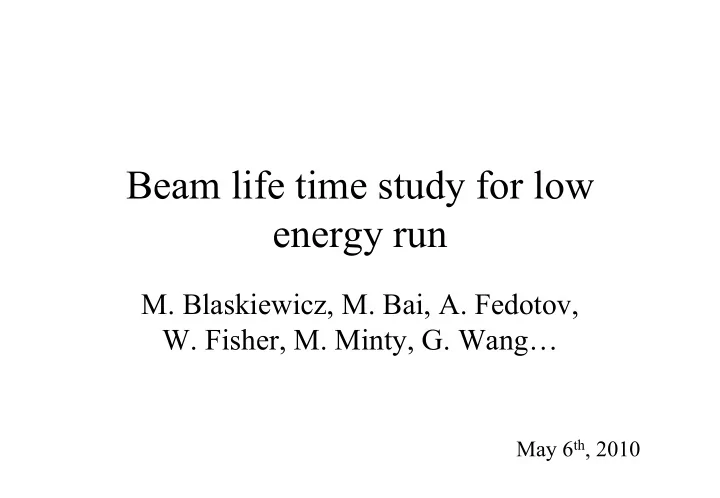

Beam life time study for low energy run M. Blaskiewicz, M. Bai, A. Fedotov, W. Fisher, M. Minty, G. Wang… May 6 th , 2010
Plan • Verify intensity dependant beam loss in yellow ring. • Verify space charge effects via octopoles in blue ring.
Yellow beam life time study
Beam Decay v.s. Beam Intensity (WCM.bunched) Initial sharp decay with lower injected intensity.
Low intensity: 0.5E10 (total intensity for 23 bunches )
High intensity: 1.5E10 (total intensity for 23 bunches )
Beam Decay v.s. Vertical Emittance DA?
Beam Decay v.s. Horizontal Emittance DA?
Blue beam life time study Injected with Set octopole to 0 octopole at 0 Injected with octopole at -8.5
Beam intensity Where we start adjusting octopoles
Blue beam life time study Where we start adjusting octopoles
Beam Decay Lower Qx to where it was Change octopoles from -4.5 to 0 Change octopoles from -8.5 to -4.5
Blue horizontal tune
Correlation of beam decay vs. Qx
Blue vertical tune
Correlation of beam decay vs. Qy
Summary • Yellow beam loss was correlated with beam intensity for the analyzed 7 sets of ‘good’ data. • For injection with low intensity (0.2E9/bunch) , an initial fast beam decay lasted for ~1 minute. • The effects of octopoles to blue beam life time is not conclusive as tune/chrom were also changed when adjusting octoples’ strengthes. However, some of the observation might be explained by the compensation of space charge incoherent tune spread with octopoles. • We did not observe coherent line from low frequency schottky spectrum and the space charge effects remains unclear.
Back up slides
Beam Decay v.s. Beam Intensity (DCCT)
Beam Decay v.s. Beam Intensity (WCM.bunched)
Beam Decay v.s. Horizontal Emittance
Beam Decay v.s. Vertical Emittance
Beam Decay v.s. Beam Intensity (WCM.bunched) Initial sharp decay for injections with lower intensity.
Beam Decay v.s. Beam Intensity (DCCT)
Recommend
More recommend